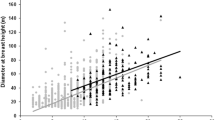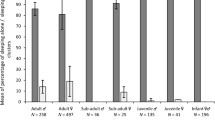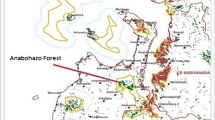Abstract
Little information is available on the sleeping cluster pattern and retiring behavior of Sichuan snub-nosed monkeys (Rhinopithecus roxellana). Here, we provide observational data on a provisioned free-ranging band in the Qinling Mountains, central China. The results suggest that winter night activity of R. roxellana is a compromise between antipredator and thermoregulatory strategies and an adaptation to ecological conditions of their temperate habitat. Monkeys retired between 1804 and 1858 h in winter. In support of the antipredation hypothesis, all monkeys slept in trees at night, whereas 18.8% of individuals slept on the ground during the day. Also, the study band was more spatially cohesive at night than in daytime, with shorter distances between one-male units. Keeping warm is critical for survival in freezing temperatures. Monkeys often slept in the lower stratum of the tree canopy, avoiding the upper canopy where it is cold and windy. They formed larger sleeping clusters at night than in daytime. The most common types of night-sleeping clusters were adult females and juveniles, followed by adult females with other adult females. These accounted for 60.2% of the total records. The frequency of female–male clusters is two times greater, and that of adult male–juvenile clusters was four times less at night than during the day. The variations in composition of sleeping clusters suggest affiliative patterns at night-sleeping sites differ from those during the day.


Similar content being viewed by others
References
Altmann J (1974) Observational study of behavior: sampling methods. Behaviour 49:227–265
Altmann J (1980) Baboon mothers and infants. Harvard University Press, Cambridge
Anderson JR (1984) Ethology and ecology of sleep in monkeys and apes. Adv Stud Behav 14:165–229
Anderson JR (1998) Sleep, sleeping sites, and sleep-related activities: awakening to their significance. Am J Primatol 46:63–75
Anderson JR (2000) Sleep-related behavioural adaptations in free-ranging anthropoid primates. Sleep Med Rev 4:355–373
Anderson JR, McGrew WC (1984) Guinea baboons (Papio papio) at a sleeping site. Am J Primatol 6:1–18
Bernstein IS (1972) Daily activity cycles and weather influences on a pigtail monkey group. Folia Primatol 16:390–415
Booth AH (1956) The distribution of primates in the Gold Coast. J West Afr Sci Assoc 2:122–133
Chalmers NR (1968) Group composition, ecology and daily activities of free living mangabeys in Uganda. Folia Primatol 8:247–262
Chen FG, Min ZL, Gan QF, Luo SY, Xie WZ (1989) Resources and protection of the golden monkey (Rhinopithcus roxellana) in Qinling Mountains. In: Chen FG (ed) Progress in the studies of golden monkey. Northwest University Press, Xi’an, pp 279–283
Davidge C (1978) Activity patterns of chacma baboons (Papio ursinus) at Cape point. Afr Zool 13:143–155
Dunbar RIM (1983) Structure of gelada baboon reproductive units II. Social relationships between reproductive females. Anim Behav 31:556–564
Dunbar RIM (1992) A model of the gelada socio-ecological system. Primates 33:69–83
Gautier-Hion A (1973) Social and ecological features of talapoin monkey-comparison with sympatric Cercopithecines. In: Michael RP, Cook JH (eds) Comparative ecology and behavior of primates. Academic Press, New York, pp 147–170
Gittins SP (1982) Feeding and ranging in the agile gibbon. Folia Primatol 38:38–71
Grueter GC, Zinner D (2004) Nested societies. Convergent adaptations of baboons and snub-nosed monkeys? Primate Rep 70:1–98
Hamilton WJ III (1982) Baboon sleeping site preferences and relationships to primate grouping patterns. Am J Primatol 3:41–53
Hamilton EJ III, Watt KEF (1970) Refuging. Annu Rev Ecol Syst 1:263–286
Harrison MJS (1983) Pattern of range use by the green monkey, Cercopithecus sabaeus, at Mt Assirik, Senegal. Behav Ecol Sociobiol 12:85–94
Hu JC, Deng QX, Yu ZW, Zhou SD, Tian ZX (1989) Research on the ecology and biology of the giant panda, golden monkey and other rare animals. In: Chen FG (ed) Progress in the studies of golden monkey. Northwest University Press, Xi’an, pp 207–215
Jay P (1965) The common langur of north India. In: DeVore I (ed) Primate behavior: field studies of monkeys and apes. Holt, New York, pp 197–249
Kawai M, Dunbar R, Ohsawa H, Mori U (1983) Social organization of gelada baboons: social units and definitions. Primates 24:13–24
Koyama N (1973) Dominance, grooming, and clasped-sleeping relationships among bonnet monkeys in India. Primates 14:225–244
Kummer H (1971) Primate societies: group techniques of ecological adaptation. Aldine, Chicago
Kummer H, Banaja AA, Abo-Khatwa AN, Ghandour AM (1985) Differences in social behavior between Ethiopian and Arabian hamadryas baboons. Folia Primatol 45:1–8
Li BG, Chen C, Ji WH, Ren BP (2000) Seasonal home range changes of the Sichuan Snub-nosed monkey (Rhinopithecus roxellana) in the Qinling Mountains of China. Folia Primatol 71:375–386
Li BG, Zhang P, Watanabe K, Tan CL, Fukuda F, Wada K (2003) A dietary shift in Sichuan Snub-nosed monkeys. Acta Theriol Sin 23:258–260
Makwana SC (1978) Field ecology and behavior of the rhesus macaques (Macaca mulatta) I: group composition, home range, roosting sites, and foraging routes in the Asarori Forest. Primates 19:483–492
Meddis R (1979) The evolution of sleep. In: Hayes A (ed) Sleep functions and mechanisms in animals and man. Van Nostrand, New York
Mori U (1979) Social structure of gelada baboons. In: Kawai M (ed) Ecological and sociological studies of gelada baboons. Kodansha Press, Tokyo, pp 243–247
Mulavwa MN, Yangozene K, Yamba-Yamba M, Motema-Salo B, Mwanza NN, Furuichi T (2010) Nest groups of wild bonobos at Wamba: selection of vegetation and tree species and relationships between nest group size and party size. Am J Primatol 72:575–586
Neyman PF (1978) Aspects of the ecology and social organization of free-ranging cotton-top tamarins (Saguinus oedipus) and the conservation status of the species. In: Kleiman DG (ed) The biology and conservation of the Callitrichidae. Smithsonian Institution Press, Washington, DC, pp 39–71
Ogawa H, Idani G, Moore J, Pintea L, Hernandez-Aguilar A (2007) Sleeping parties and nest distribution of chimpanzees in the savanna woodland, Ugalla, Tanzania. Int J Primatol 28:1397–1412
Qi JF (1989) The feed and reproduction of the golden monkey. In: Chen FG (ed) Progress in the study of golden monkey. Northwest University Press, Xi’an, pp 287–292
Qi XG, Li BG, Tan CL, Gao YF (2004) Spatial structure in a Sichuan golden snub-nosed monkey Rhinopithecus roxellana group in Qinling Mountains while being in no-locomotion (in Chinese with English abstract). Acta Zool Sin 50:697–705
Qi XG, Li BP, Ji WH (2008) Reproductive parameters of wild female Rhinopithecus roxellana. Am J Primatol 70:311–319
Rahaman H, Parthasarathy MD (1969) Studies on the social behavior of bonnet monkeys. Primates 10:149–162
Reichard U (1998) Sleeping sites, sleeping places and pre-sleeping behavior of gibbons (Hylobates lar). Am J Primatol 46:35–62
Ren RM, Yan KH, Su YJ, Zhou Y, Li JJ (2000) The society of golden monkey (Rhinopithecus roxellana). Beijing University Press, Beijing, pp 148–168
Shi DC, Li GH, Hu TQ (1982) Preliminary study on the ecology of golden haired monkey. Zool Res 3:105–110
Sigg H, Stolba A (1981) Home range and daily march in a hamadryas baboon troop. Folia Primatol 36:40–75
Southwick CH, Beg MA, Siddiqi MR (1965) Rhesus monkeys in north India. In: DeVore I (ed) Primate behavior: field studies of monkeys and apes. Holt, New York, pp 111–159
Stolz LP, Saayman GS (1970) Ecology and behavior of baboons in the northern Transvaal. Ann Transv Mus 26:99–143
Swedell L (2002) Ranging behavior, group size and behavioral flexibility in Ethiopian hamadryas baboons (Papio hamadryas hamadryas). Folia Primatol 73:95–103
Takahashi H (1997) Huddling relationships in night sleeping groups among wild Japanese macaques in Kinkasan Island during winter. Primates 38:57–68
Vessey SH (1973) Night observation of free-ranging rhesus macaques. Am J Phys Anthropol 38:613–620
Wada K, Tokida E (1985) Sleeping site cluster of Japanese macaques in Shiga A1 troop: about inter-individual relationships. In: Primate Research Institute (ed) The study of spatial distribution of Japanese macaque troops in Shiga Heights. Kyoto University Press, Kyoto, pp 2–10
Xi WZ, Li BG, Zhao DP, Ji WH, Zhang P (2008) Benefits to female helpers in wild Rhinopithecus roxellana. Int J Primatol 29:593–600
Zhang P, Watanabe K (2007) Extra large rest clusters of Japanese monkeys (Macaca fuscata) in Shodo Island. Am J Primatol 69:1119–1130
Zhang SY, Ren BP, Li BG (1999) A juvenile Sichuan golden monkey (Rhinopithecus roxellana) predated by a goshawk (Accipiter gentilis) in the Qinling Mountains. Folia Primatol 70:175–176
Zhang P, Li BG, Wada K, Tan CL, Watanabe K (2003) Social structure of Sichuan snub-nosed monkeys (Rhinopithecus roxellana) in the Qinling Mountains of China. Acta Zool Sin 49:727–735
Zhang P, Watanabe K, Li BG (2006a) Forest strata utilization of Sichuan snub-nosed monkeys (Rhinopithecus roxellana) in their natural habitat. Acta Zool Sin 52:429–436
Zhang P, Watanabe K, Li BG, Tan CL (2006b) Social Organization of the Sichuan snub-nosed monkeys (Rhinopithecus roxellana) in the Qinling Mountains of China. Primates 47:374–382
Zhang P, Watanabe K, Li BG (2008a) Female social dynamics in a provisioned free-ranging band of the Sichuan snub-nosed monkey (Rhinopithecus roxellana) in the Qinling Mountains, China. Am J Primatol 70:1–10
Zhang P, Watanabe K, Li BG, Qi XG (2008b) Dominance relationships among one-male units in a provisioned free-ranging band of the Sichuan snub-nosed monkeys (Rhinopithecus roxellana) in the Qinling Mountains, China. Am J Primatol 70:634–641
Acknowledgments
The study was supported by the National Natural Science Foundation of China (31000175, 30970444 and 30570312) and Fund-In-Aid of JSPS (P09103) in Japan. The authors are grateful to Zhouzhi Nature Reserve for giving us permission to carry out this research. We thank Dr. Amy L. Schreier and Andrew J. Macintosh for improving the language in the article. We thank all members of the Anthropology Department in Sun Yat-sen University China and those of the Social Ecology Department in the Primate Research Institute, Kyoto University, Japan, who gave us helpful comments on the manuscript.
Author information
Authors and Affiliations
Corresponding author
About this article
Cite this article
Zhang, P., Li, Bg., Watanabe, K. et al. Sleeping cluster patterns and retiring behaviors during winter in a free-ranging band of the Sichuan snub-nosed monkey. Primates 52, 221–228 (2011). https://doi.org/10.1007/s10329-011-0241-y
Received:
Accepted:
Published:
Issue Date:
DOI: https://doi.org/10.1007/s10329-011-0241-y




